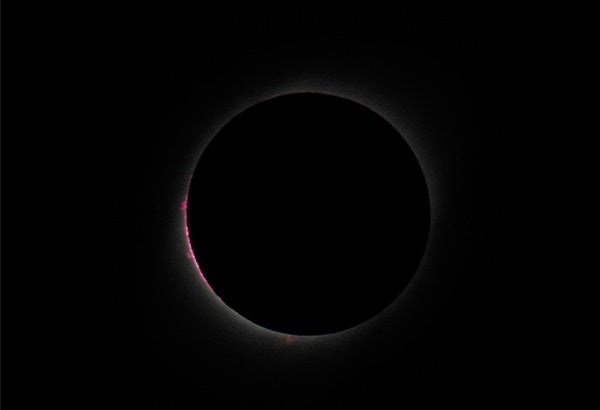The next three months offer the year’s shortest nights and highest-up Sun. Seems like a no-brainer: It’s solar-observing time! No celestial object is easier to find or to aim a scope at. Just swivel the tube around until its shadow is perfectly round.
In the old days, budget limited my solar observing toolkit to a simple Sun filter. I’d see things like sunspots and surface granulation — happy times, augmented by being 40 years younger and accompanied by admiring girlfriends whom I suspect imagined I was a Galileo analogue (but better looking). These days, views are even more dramatic for us lucky hobbyists with H-alpha telescopes that reveal breathtaking geyserlike prominences on the Sun’s limb.
So, you’re set for daytime amazement. But you still have to be careful. An Astronomy reader wrote me a few years ago to share how one of his eyes had been ruined when he’d been too careless sweeping his telescope near the Sun, seeking Mercury. While it’s widely known that staring at the Sun is hazardous, even a short accidental peek at it through a telescope or binoculars is likely to permanently destroy retina cells.
The danger ramps up during solar eclipses. My favorite totality instrument is a pair of image-stabilized binoculars. During the 2017 eclipse, my wife, Marcy, was using one. When totality was almost over, she suddenly shouted, “The right side of the Sun just turned purpley-red!”
We swiveled our heads and yelled for her to put down the binoculars, and she complied just as the diamond ring appeared. She’d saved her eyes in a close call. But what had she seen? Betcha some of you are now shouting: the chromosphere!
Yep. The same deep red that paints those prominences forms a continuous layer around the Sun, glowing in pure hydrogen-alpha. The only chance to see it naturally is during the brief seconds when the moving Moon has just finished blocking it but will momentarily expose the perilous photosphere. It’s a rare celestial wonder viewable for only a mere three seconds or so. Who would take that chance? Well, Marcy did, accidentally observing the achingly beautiful phenomenon around half the Sun. I’d never seen it myself in all my totalities, starting with Virginia Beach in 1970 — until her experience motivated me to unwise heights of bravery two years later in Chile. And happily, I succeeded.
Of course, many would have dissuaded me from trying. Before the May 10, 1994, annular eclipse in Albany, New York, I warned listeners on WAMC Northeast Public Radio not to observe any part of that event without a proper filter. When we accepted on-air questions, 450,000 listeners in eight states heard one caller sincerely ask, “If the eclipse is so dangerous, why are they having it?”
True story. Anyway, with a rare U.S. totality in just two years and the year’s best Sun viewing now upon us, let’s talk about how to safely see the Sun. Floppy plastic filters in cardboard frames have recently become popular. They are cheap and show the Sun in a nice-looking orange hue. Their only downside is they easily scratch, leaving spots that expose the Sun’s full light.
Alternatively, on the tours I’ve led for decades, we always supply welder’s filters in shade 12, 13, or 14. They’re all government certified, scratch-proof, optically excellent glass, but take heed: No lower-number shade is safe. Lately I’ve offered pre-eclipse tryouts. Without exception, people prefer the brighter solar image that 12s and 13s produce and find 14s unpleasantly dark. I personally have used 12s for all 10 of my eclipses, but they do deliver a slightly bright-looking Sun image. Smack dab in the middle, I’ve come to believe that 13s hit the sweet spot.
Since these are hardest to find, it may be smart to avoid the next eclipse rush and head soon to your local welding-supply store and order a bunch of 13 filters. What the heck — if you buy them in lightweight goggles, you can even view the Sun hands-free and attain our ultimate goal: safe, zero-effort science.










